Arlington Heights, Illinois
Arlington Heights is a municipality in Cook County in the U.S. state of Illinois. A suburb of Chicago, it lies about 25 miles (40 km) northwest of the city's downtown.[3] The population was 75,101 at the 2010 census.[4] It is the most populous community in the United States that is incorporated as a "village", and is the 13th most populous municipality in Illinois, although it is not far ahead of its nearby Illinois neighboring villages of Schaumburg and adjacent Palatine.
Arlington Heights | |
|---|---|
Village | |
| Village of Arlington Heights | |
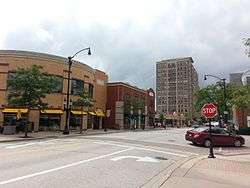 Evergreen Avenue in Downtown Arlington Heights | |
.jpg) Seal | |
| Nickname(s): Action Heights | |
| Motto(s): City of Good Neighbors | |
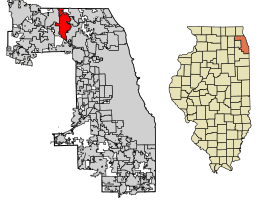 Location of Arlington Heights in Cook County, Illinois. | |
.svg.png) Location of Illinois in the United States | |
 Arlington Heights Location in Illinois  Arlington Heights Arlington Heights (the United States)  Arlington Heights Arlington Heights (North America) | |
| Coordinates: 42°5′42″N 87°58′51″W | |
| Country | |
| State | Illinois |
| Counties | Cook |
| Township | Wheeling |
| Incorporated | 1887 |
| Government | |
| • Type | Council–manager |
| • Mayor | Thomas Hayes |
| Area | |
| • Total | 16.64 sq mi (43.09 km2) |
| • Land | 16.61 sq mi (43.01 km2) |
| • Water | 0.03 sq mi (0.08 km2) |
| Elevation | 700 ft (200 m) |
| Population (2010) | |
| • Total | 75,101 |
| • Estimate (2019)[2] | 74,760 |
| • Density | 4,502.26/sq mi (1,738.30/km2) |
| Standard of living | |
| Time zone | Central |
| ZIP code(s) | 60004, 60005, and 60006 (PO boxes) |
| Area code(s) | 847 and 224 |
| Geocode | 02154 |
| FIPS code | 17-02154 |
| Website | www |
Arlington Heights is known for Arlington Park Race Track, home of the Arlington Million, a Breeders' Cup qualifying event; it also hosted the Breeders' Cup World Thoroughbred Championships in 2002. The village is also home to the Arlington Heights Memorial Library, which has one of the largest collections of books in the state.
History
Arlington Heights lies mostly in the western part of Wheeling Township, with territory in adjacent Elk Grove and Palatine townships, in an area originally notable for the absence of groves and trees. The General Land Office began selling land here in 1835. In 1853, William Dunton, originally from Oswego, New York, persuaded the Illinois & Wisconsin Railroad to make a stop here, and laid out a town called Dunton. Dunton Avenue, named after William Dunton, is the village's base line that splits addresses east and west, with Campbell Street splitting north and south.
By 1850, the area had largely changed its ethnic composition, as many German farmers from Saxony had arrived during the 1840s. John Klehm might serve as an example; he was at first a potato farmer, supplying the Chicago market, and in 1856 began a nursery for cherry, apple, and pear trees, later moving into spruce, maple, and elm, and then flowers. By the late 1850s the area had become noted for its truck farms, sending dairy products as well as vegetables to Chicago on the railroad.
The little town at the depot slowly grew, acquiring a blacksmith, a cheese factory, a hardware store, and a hotel. It incorporated as Arlington Heights in 1887, when its population numbered about 1,000. Most were farmers, but they were joined by others who worked in Chicago, since Arlington Heights was an early commuter suburb.
Religious heritage
The town developed religious institutions that reflected the origins of its citizens. The first churches were Presbyterian (1856) and Methodist (1858), with St. Peter Lutheran Church, a German Lutheran church, following in 1860. Today, the village has many Roman Catholics, boasting three very large churches: St. James (founded 1902—now home to 4,600 registered families), St. Edna (2,800 registered families), and Our Lady of the Wayside (3,100 registered households), in addition to several large Lutheran churches, Evangelicals and several other Protestant churches, including two United Churches of Christ, an Episcopal Church and a Christian Church (Disciples of Christ).
Arlington Park Racetrack
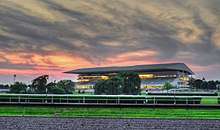
By the start of the 20th century Arlington Heights had about 1,400 inhabitants, and it continued to grow slowly with a good many farms and greenhouses after World War II. By then Arlington Heights was also known for Arlington Park, a racetrack founded in 1927 by the California millionaire Harry D. "Curly" Brown upon land formerly consisting of 12 farms. Camp McDonald and two country clubs were founded in the 1930s. On July 31, 1985, a fire burned down the grandstand. The current six-story grandstand was completed and opened for use June 28, 1989.
Population increase
A population explosion took place in the 1950s and 1960s, when the spread of automobile ownership, together with the expansion of the Chicago-area economy, the baby boom, and white flight from the city, drove the number of people in Arlington Heights—expanded by a series of annexations—up to 64,884 by 1970. By then virtually all the available land had been taken up, and the formerly isolated depot stop found itself part of a continuous built-up area stretching from Lake Michigan to the Fox River.[5]
Geography
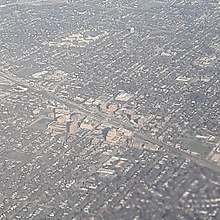

Arlington Heights is located at 42°05′42″N 87°58′51″W (42.094976, −87.980873).[6]
According to the 2010 census, Arlington Heights has a total area of 16.639 square miles (43.09 km2), of which 16.61 square miles (43.02 km2) (or 99.83%) is land and 0.029 square miles (0.08 km2) (or 0.17%) is water.[7]
Business
Arlington Heights has experienced a recent boom in development of condos, restaurants and other businesses in the Central Business District or downtown area of Arlington Heights, with restaurants experiencing the greatest overall success. Some of the most popular restaurants include Javier's Sabor Mexicano, Peggy Kinanes, Mago Grill, TTOWA Korean Bistro, Shakou, La Tasca and Francescas. Although land and space is now limited in Arlington Heights, business and community development along with community design are key concerns. The Village of Arlington Heights is also instrumental in business, residential and community development. The community is served by many fine hotels.
BYD Company, a Chinese technology firm, has a sales office in Arlington Heights.[8]
Top employers
According to the Village's 2017 Comprehensive Annual Financial Report,[9] the top employers in the city are:
| # | Employer | # of Employees |
|---|---|---|
| 1 | Arlington International Racecourse (seasonal) | 4,500 |
| 2 | Northwest Community Healthcare | 3,600 |
| 3 | Arlington Heights High School District #214 | 1,700 |
| 4 | Clearbrook | 1,500 |
| 5 | Lutheran Home | 800 |
| 6 | Paddock Publications | 500 |
| 7 | Alexian Brothers Health System | 500 |
| 8 | Clearbrook | 450 |
| 9 | Kroeschell Inc. | 450 |
| 10 | Village of Arlington Heights | 450 |
Notable people
In the movies
The following movies were partially filmed in Arlington Heights:
- Lucas (1986) (many scenes filmed at the former Arlington High School including the former Grace Gym and Foyer)[10]
- A Nightmare on Elm Street (2010 film) (high school scenes filmed at John Hersey High School)[11]
- The Lucky Ones (2008)[12]
- Blood and Wine (1996)[13]
- Normal Life (1996)[14]
- Uncle Nino (2003)[15]
- Bernadette (2018)[16]
Entertainment venues
From 1964 to 1970, Arlington Heights served as the home to The Cellar. The club was located in an unused warehouse on Davis Street, along the Chicago and Northwestern railroad tracks. Founded by local record store owner Paul Sampson, The Cellar offered live rock and blues bands for its mostly teenage audience to listen and to dance. It hosted a wealth of regional bands and repeat performers, such as The Shadows of Knight, The Mauds, H. P. Lovecraft, and Ted Nugent. It also hosted a significant array of national and international rock bands as well, including The Who, The Byrds, Buffalo Springfield, Cream, and The Spencer Davis Group.[17]
Entertainment venues include the Metropolis Performing Arts Centre in downtown Arlington Heights, which opened in 1999. The Metropolis Performing Arts Centre includes live entertainment as well as arts education. The facility includes a 350-seat theatre, ballroom and classrooms for music and theatre. Music venue Hey Nonny opened in 2018.
Transportation
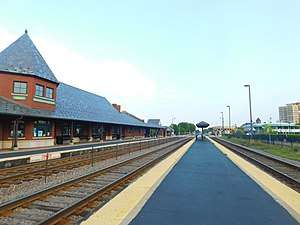
Arlington Heights has two stations (Arlington Heights and Arlington Park) on Metra's Union Pacific/Northwest Line, which provides daily rail service between Harvard, Illinois, and Chicago. Other nearby rail service includes the Metra North Central Line. Metra's proposed STAR line, if it were to be funded and built, would likely include a third station on the far south end of Arlington Heights.
Interstate 90 and Illinois Route 53 (northern extension of Interstate 290) run along the south and western edges, respectively, of the city, providing easy access to nearby O'Hare International Airport, the city of Chicago, and other suburbs.
Arlington Heights Road is a main street running north–south through all of central Arlington Heights. Running to the south it passes through Elk Grove Village, and its southern terminus is in Itasca of DuPage County. Running north it passes through Buffalo Grove, and its northern terminus is in Long Grove of Lake County. Northwest Highway (U.S. Route 14) runs northwest–southeast through central Arlington Heights, from Chicago to Crystal Lake of McHenry County. Other major streets/roads include Rand Road (U.S. Route 12), Golf Road (Illinois Route 58), Algonquin Road (Illinois Route 62), Dundee Road (Illinois Route 68), Palatine Road, Central Road, Hintz Road, Euclid Avenue, Dunton Avenue, Campbell Street, White Oak Street, Thomas Street, Olive Street, Oakton Street, Kennicott Avenue, Ridge Avenue, Dryden Avenue and Windsor Drive.
Demographics
| Historical population | |||
|---|---|---|---|
| Census | Pop. | %± | |
| 1890 | 1,424 | — | |
| 1900 | 1,380 | −3.1% | |
| 1910 | 1,943 | 40.8% | |
| 1920 | 2,250 | 15.8% | |
| 1930 | 4,997 | 122.1% | |
| 1940 | 5,668 | 13.4% | |
| 1950 | 8,768 | 54.7% | |
| 1960 | 27,878 | 218.0% | |
| 1970 | 65,058 | 133.4% | |
| 1980 | 66,116 | 1.6% | |
| 1990 | 75,460 | 14.1% | |
| 2000 | 76,031 | 0.8% | |
| 2010 | 75,101 | −1.2% | |
| Est. 2019 | 74,760 | [2] | −0.5% |
| U.S Census Bureau[18] U.S. Census Bureau[19] | |||
As of the census[20] of 2000, there were 76,031 people, 30,763 households, and 20,518 families residing in the village. The population density was 7,633.3 per square mile (2,947.2/km2). There were 131,725 housing units at an average density of 11,933.3 per square mile (4,607.5/km2). The racial makeup of the village was 90.56% White, 0.96% African American, 0.08% Native American, 5.98% Asian, 0.04% Pacific Islander, 1.19% from other races, and 1.19% from two or more races. Hispanic or Latino of any race were 4.46% of the population.
There were 30,763 households, out of which 99.2% had children under the age of 18 living with them, 58.4% were married couples living together, 6.3% had a female householder with no husband present, and 33.3% were non-families. 29.0% of all households were made up of individuals, and 15% had someone living alone who was 65 years of age or older. The average household size was 2.44 and the average family size was 3.05.
In the village, the population was spread out, with 23.1% under the age of 18, 6.0% from 18 to 24, 29.8% from 25 to 44, 25.0% from 45 to 64, and 16.1% who were 65 years of age or older. The median age was 40 years.
Climate
.jpg)
| Climate data for Arlington Heights, Illinois | |||||||||||||
|---|---|---|---|---|---|---|---|---|---|---|---|---|---|
| Month | Jan | Feb | Mar | Apr | May | Jun | Jul | Aug | Sep | Oct | Nov | Dec | Year |
| Record high °F (°C) | 62 (17) |
69 (21) |
83 (28) |
89 (32) |
93 (34) |
102 (39) |
103 (39) |
100 (38) |
96 (36) |
88 (31) |
75 (24) |
66 (19) |
103 (39) |
| Average high °F (°C) | 28 (−2) |
33 (1) |
44 (7) |
57 (14) |
68 (20) |
78 (26) |
82 (28) |
79 (26) |
72 (22) |
60 (16) |
47 (8) |
33 (1) |
57 (14) |
| Daily mean °F (°C) | 21 (−6) |
25 (−4) |
35 (2) |
48 (9) |
58 (14) |
68 (20) |
73 (23) |
70 (21) |
62 (17) |
51 (11) |
39 (4) |
26 (−3) |
48 (9) |
| Average low °F (°C) | 13 (−11) |
17 (−8) |
26 (−3) |
38 (3) |
48 (9) |
58 (14) |
63 (17) |
61 (16) |
52 (11) |
41 (5) |
30 (−1) |
18 (−8) |
39 (4) |
| Record low °F (°C) | −26 (−32) |
−21 (−29) |
−9 (−23) |
5 (−15) |
22 (−6) |
35 (2) |
38 (3) |
38 (3) |
25 (−4) |
14 (−10) |
−10 (−23) |
−20 (−29) |
−26 (−32) |
| Average precipitation inches (mm) | 1.90 (48) |
1.97 (50) |
2.29 (58) |
3.56 (90) |
4.24 (108) |
3.85 (98) |
3.78 (96) |
4.86 (123) |
3.40 (86) |
3.10 (79) |
3.04 (77) |
2.26 (57) |
38.25 (970) |
| Source: weather.com[21] | |||||||||||||
Local media
Arlington Heights media
- The Daily Herald, the major locally owned and operated newspaper for Arlington Heights and many other Chicago suburbs
- Journal & Topics, covering Arlington Heights, Buffalo Grove, Palatine, Rolling Meadows, and Wheeling.
- The Correspondent, student newspaper of John Hersey High School.[22]
Education
Primary and secondary schools
Public elementary schools and middle schools that serve most of the city are operated by Arlington Heights School District 25.[23] Portions of the city are also served by Prospect Heights School District 23, Wheeling School District 21, Elk Grove School District 59 and Community Consolidated School District 15. Seventeen elementary schools and nine middle schools serve sections of Arlington Heights.[24][25]
Public high schools serving most of the community are operated by Township High School District 214. There is one public high school in the city, John Hersey High School. Other District 214 high schools serving sections of the city are: Buffalo Grove, Prospect, Rolling Meadows, and Wheeling. Portions of the city are also served by Palatine High School (Palatine, Illinois) in Township High School District 211.[26] During peak enrollment from the 1960s to the 1980s, there were three public high schools in Arlington Heights: Hersey, Arlington High School, and Forest View High School.
Arlington High School was the original high school founded in 1922, but was closed in 1984, and is now the private Christian Liberty Academy. Forest View High School was closed in 1986, but serves as the administration center for the district. Today Arlington Heights high school students attend Rolling Meadows High School, Prospect High School, John Hersey High School and Buffalo Grove High School, with small portions attending Wheeling High School, Elk Grove High School, and Palatine High School (Palatine, Illinois).[27]
There are also several private schools in Arlington Heights, such as St. Viator High School, Our Lady of Wayside School, St. James School, St. Peter Lutheran School and Christian Liberty Academy. Chicago Futabakai Japanese School, which offers day classes for Japanese students as well as weekend supplemental instruction, is located in Arlington Heights, in a former middle school. It moved there from Niles in 1998.[28]
Public library
The Arlington Heights Memorial Library is a nationally award-winning[29] public library in the village.[30] According to the Institute of Museum & Library Services' Public Libraries Survey, in 2014, 63.5 percent of Arlington Heights residents (47,713 out of a service area population of 75,101) held library cards,[31] entitling cardholders to borrowing privileges. For seven consecutive years, the library received a 5-star rating in Library Journal's national rating of public libraries, making it one of 21 libraries in the United States to earn five stars for the past seven years.
The library has books, magazines, CDs, DVDs and books on CD in 17 different languages. The Arlington Heights Memorial Library maintains the Arlington Heights Community Information web site. Computers are available for public use, and library card holders can also check out a laptop to use within the library. Wifi is available throughout the library.
The bookmobile stops in 29 Arlington Heights neighborhoods, delivering books, DVDs, and music. Village residents who are temporarily or permanently homebound due to an illness or physical disability may have library items brought to their homes through the Library Visitor Program. Participants may request books, audiobooks, videos, and other materials that will be delivered monthly by a library volunteer. The Library meets other special needs as well.
The library sponsors seven book discussion clubs, and two more at the Arlington Heights Senior Center in addition to a film discussion group. The library also maintains a reading room and computer room at the senior center.
Live homework help is available for students in grades 4–12 on the library's web site through Tutor.com. Ten summer volunteer squads attracted more than 250 students in 7th through 12th grade to learn life skills and teamwork. The literacy office at the library has eight computers with software to improve English skills, conversation programs and adult basic reading books. The library also offers free literacy and ESL classes in cooperation with Township High School District 214.
One Book, One Village is an annual community reading project which features a selected title an author each year, with book discussions, Meet the Author and related programs.
Notable landmarks and establishments
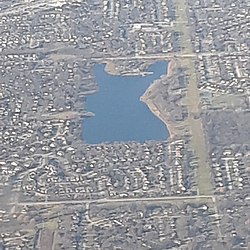
- Lake Arlington
- Mitsuwa Marketplace - Chicago
- 1000 gecs tree
See also
References
- "2019 U.S. Gazetteer Files". United States Census Bureau. Retrieved July 14, 2020.
- "Population and Housing Unit Estimates". United States Census Bureau. May 24, 2020. Retrieved May 27, 2020.
- "Arlington Heights Mayor (Andrew Robinson) Promotes Downtown Revival". usmayors.org. Archived from the original on 13 January 2013. Retrieved 2 May 2018.
- "Arlington Heights (village) QuickFacts from the US Census Bureau". census.gov. Archived from the original on 17 February 2016. Retrieved 2 May 2018.
- Buisseret, David, "Arlington Heights, IL" Archived 2008-10-21 at the Wayback Machine, Encyclopedia of Chicago (accessed Nov 12, 2008)
- "US Gazetteer files: 2010, 2000, and 1990". United States Census Bureau. 2011-02-12. Retrieved 2011-04-23.
- "G001 - Geographic Identifiers - 2010 Census Summary File 1". United States Census Bureau. Archived from the original on 2020-02-13. Retrieved 2015-08-01.
- "Contact Us Archived 2015-02-22 at the Wayback Machine." BYD Company. Retrieved on June 17, 2015. "BYD America Corporation Add.: 1500 West Shure Drive [sic], Suite 250, Arlington Heights, IL 60004 "
- "Village of Arlington Heights, Illinois Comprehensive Annual Financial Report". 2018-04-25.
- "Lucas (1986)". Archived from the original on 16 March 2016. Retrieved 2 May 2018 – via www.imdb.com.
- "A Nightmare on Elm Street (2010)". Archived from the original on 5 March 2016. Retrieved 2 May 2018 – via www.imdb.com.
- "The Lucky Ones (2008)". Archived from the original on 14 March 2016. Retrieved 2 May 2018 – via www.imdb.com.
- "Blood and Wine (1996)". Archived from the original on 4 March 2016. Retrieved 2 May 2018 – via www.imdb.com.
- "Normal Life (1996)". Archived from the original on 1 February 2016. Retrieved 2 May 2018 – via www.imdb.com.
- "Uncle Nino (2003)". Archived from the original on 6 March 2016. Retrieved 2 May 2018 – via www.imdb.com.
- Cullotta, Karen Ann. "Arlington Heights' Frontier Park becomes John Hughes-style movie set". chicagotribune.com. Retrieved 2019-05-15.
- Lind, Jeff, "History of Chicago Rock" Archived 2008-01-13 at the Wayback Machine, Illinois Entertainer (July 1978) (accessed May 18, 2008)
- "Historical Census Data". quickfacts.census.gov. Archived from the original on 2015-09-05. Retrieved 2015-10-01.
- Historical Census Data Archived 2012-10-22 at the Wayback Machine Retrieved on 2012-5-29
- "U.S. Census website". United States Census Bureau. Retrieved 2008-01-31.
- "Monthly Averages for Arlington Heights, Illinois". The Weather Channel. Archived from the original on 2014-08-10.
- "Correspondent Live – The student news site of John Hersey High School". correspondentlive.com. Archived from the original on 2018-02-07. Retrieved 2018-02-10.
- "School District 25 Archived 2016-12-12 at the Wayback Machine." Arlington Heights. Retrieved on January 20, 2017.
- "Elementary School Districts Archived 2017-01-10 at the Wayback Machine." Arlington Heights. Retrieved on January 20, 2017.
- "Middle School Districts Archived 2016-12-12 at the Wayback Machine." Arlington Heights. Retrieved on January 20, 2017.
- "High School Districts Archived 2016-12-12 at the Wayback Machine." Arlington Heights. Retrieved on January 20, 2017.
- "High School Districts Archived 2016-12-12 at the Wayback Machine."
- Deardorff, Julie and Karen Cullotta Krause. "SCHOOL MOURNS IN ITS OWN WAY THOUGH OUTWARD SIGNS OF GRIEF WERE FEW, A SOMBER FUTABAKAI STUDENT BODY AND FACULTY GRAPPLED WITH THE DEATHS OF AN ADMINISTRATOR AND AN ART TEACHER IN MONDAY'S HELICOPTER CRASH. AS ONE SCHOOL OFFICIAL PUT IT: `IN JAPAN, WE ARE NOT CRYING OUT; IT IS MORE ON THE INSIDE.' Archived 2013-02-22 at the Wayback Machine" Chicago Tribune. May 20, 1998. Metro Northwest Start Page 1. Retrieved on January 10, 2012.
- http://www.ahml.info/node/100005142
- "Arlington Heights Memorial Library - adding value in your life". www.ahml.info. Archived from the original on 24 February 2018. Retrieved 2 May 2018.
- "PLS Data and Reports". Institute of Museum and Library Services. 2016-08-03. Archived from the original on 2017-02-02. Retrieved 2017-01-31.
External links
| Wikivoyage has a travel guide for Arlington Heights. |
| Wikimedia Commons has media related to Arlington Heights, Illinois. |
.jpg)

